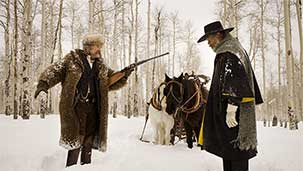Normally I don’t have much interest in whether a movie is shot on film or digital—in the sense that neither format is intrinsically superior to the other. Watching what Roger Deakins does with Sicario (a movie shot digitally) or the kind of storytelling vérité facilitated by the amped up iPhones of Tangerine, it is glaringly obvious that it is a po-tay-toe, po-tah-toe situation. But in the case of The Hateful Eight it would be much less interesting as a film without the distinctive flavor you bring to the table.
What Tarantino does with the space within the frame and depth of detail, the richer colors your presence signals, the way he frames the action and plays with long takes—two or three characters will move through the background of a long static shot, telling their own story in counterpoint to the character in the foreground, or the camera will change focal points several times in the same take—really makes this a film that is utterly married to its format.
Which is a good thing, all that business, because otherwise this is like every other film Tarantino has made since the first Kill Bill—an utterly empty exercise in formalism. Each film since then, including the The Hateful Eight, has been an adolescent revenge fantasy usually linked to a dilettante’s understanding of history, and is inevitably stuffed to the brim with thematic and visual callbacks to the kinds of films Tarantino fetishizes.
These films lack two essential things: the characters are so cartoonishly drawn that I honestly couldn’t care less what happens to them, (in contrast to when Vincent Vega gets gunned down on the toilet in Pulp Fiction—that was some real pathos), and there is no there there. The endless masturbatory references to the kinds of films Quentin likes is nothing but a pointless distraction, a kind of empty cultural signaling that becomes what the film is about. One of those kinds of films is probably enough for any filmmaker but it seems like this is the whole of Tarantino’s arsenal these days.
The dark promise of Reservoir Dogs, the manic genius of Pulp Fiction, the assured storytelling maturity of Jackie Brown all seem lost beneath an increasing tendency Tarantino has to parody his own tropes. Extended dialogue scenes that used to crackle are now so overtly constructed they trip over their own intentional cleverness. Violence that was once brutal and gritty in its heightened reality (Uma taking a needle to her chest—just the sound that made) has been replaced with Looney Tunes-esque, Daffy-getting-his-bill-turned-upside-down nonsense. Kurt Russell makes one character’s head literally disappear, like some two-bit frontier magician.
In these reviews, we offer a short plot summary to let everyone know what they are going to see. Usually all that’s required is a light sketch, but it could be a wall-sized mural and it wouldn’t make a bit of difference to anyone’s understanding of this story, because Tarantino isn’t really a storyteller anymore. He has become his own kind of cultural event, a continuous and never-ending performance piece aided and abetted by the kind of stunt casting you represent. Because as masterfully as you are utilized here, your beauty and depth is in aid of a whole lot of sound and fury, signifying absolutely nothing.
Sincerely,

Tim







